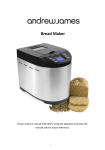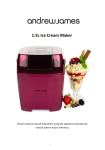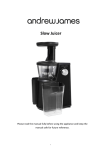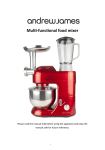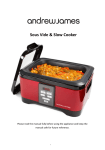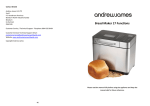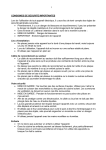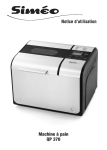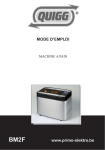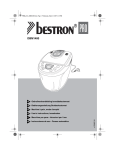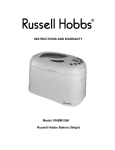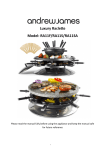Download Bread Maker with scales
Transcript
Bread Maker with scales Please read the manual fully before using the appliance and keep the manual safe for future reference. Contents Page Safety instructions Page 4 Appliance specific safety instructions Page 5 Appliance components illustration Page 6 Control panel & programmes Programmes: Page 8 Start/ Stop Page 8 Pause Page 8 Light Page 8 Menu Page 9 Basic Page 9 Whole wheat Page 9 French Page 9 Quick Page 9 Sweet Page 9 Cake Page 9 Jam Page 9 Dough Page 10 Ultra-fast Page 10 Bake Page 10 Gluten free Page 10 Home made Page 10 Colour Page 11 Loaf size Page 11 Delay function Page 11 Other programmes Page 11 Built in electronic scales Page 14 Using the bread maker for the first time Page 16 Instruction for use Page 17 2 Using the appliance to make a loaf Page 17 Ingredients information Page 19 Hints & tips Page 22 Recipes Page 23 Care & cleaning Page 31 Troubleshooting Page 32 Disposal of the appliance Page 35 UK & EU Guarantee Page 36 Electrical information Page 37 Contact details Page 38 3 Safety instructions When using any electrical appliance, basic safety precautions should always be followed including: This appliance can be used by children aged from 8 years and above and persons with reduced physical, sensory or mental capabilities or lack of experience and knowledge if they have been given supervision or instruction concerning use of the appliance in a safe way and understand the hazards involved. Children shall not play with the appliance. Cleaning and user maintenance shall not be made by children unless they are older than 8 and supervised. Keep the appliance and its cord out of reach of children less than 8 years old. Always ensure the voltage on the rating label corresponds to the voltage in your home. Check the power cord and plug regularly for any damage. If the cord or the plug is damaged, it must be replaced by a qualified electrician or a service repair centre. If in doubt please contact our customer service team. The appliance is intended for domestic use only. Industrial or commercial use will void the warranty. The supplier cannot be held responsible for injury or damage if the appliance has been used for anything other than its intended use. Incorrect operation and use can damage the appliance and cause injury to the user. Do not use the appliance if it has been dropped or damaged in any way. If the unit has been damaged take the unit for examination and or repair by an authorised service agent. Do not immerse or expose the motor assembly, plug or the power cord in water or any other liquid for any reason. If the supply cord is damaged, it must be replaced by the manufacturer or by someone who is suitably qualified to avoid a potential hazard. Do not let the cord hang over the edge of a table or counter. Ensure that the cord is not in a position where it can be pulled or tripped over accidentally. Do not allow the cord to touch hot surfaces and do not place the cord near hot gas, electric burners or in a heated oven. Use of an extension cord with this appliance is not recommended. However if it is necessary to use an extension cord, ensure that the extension cord is equal to or greater than the power consumption of the appliance to avoid overheating of the appliance and extension cord. Do not use any other appliance on the extension cord. Do not place the extension cord in a position where it can be pulled on by children or animals or be tripped over. Always operate the appliance on a smooth, even and stable surface. Do not place the unit on a hot surface. Always remove the plug of the appliance safely. Do not pull on the appliances cord to remove the appliance plug from the electrical socket. Never handle or operate the appliance with wet hands. 4 Appliance specific safety instructions Do not place the appliance near hot gas/electric burners or in a heated oven. Do not touch any moving or spinning parts of the machine while it is in operation. Never switch on the appliance if the bread pan is not positioned correctly, or if the bread pan is not filled with ingredients (except for the initial burning off of substances left on during the manufacturing process). Never beat the top or the edge of the bread pan to remove the bread as this may damage the bread pan. Metal foils or other materials must not be inserted into the bread maker as this can cause a fire or short circuit the appliance. Never cover the bread maker with a towel or any other material. Heat and steam must be able to escape freely. A fire can be caused if it is covered by or comes into contact with combustible material. Do not use the appliance outdoors. The appliance has been incorporated with a grounded plug. Please ensure the wall outlet in your house is well earthed. Do not touch the hot surfaces of the appliance during operation. The appliance is not intended to be operated by means of an external timer or separate remote-control system. Do not operate the unit without the bread pan placed in the chamber. Do not use accessories or attachments with this appliance that are not recommended by the manufacturer. Do not use the appliance if it has been damaged or dropped in anyway. After using the appliance allow it too cool completely before handling it. Do not move the bread maker whilst it is in use. 5 Appliance components illustration View window Lid Bread pan (with kneading blade) Control panel Electronic scale Housing Ingredients box Drawer Hook Measuring cup Measuring spoon 6 Control panel and programmes Control Panel layout Plug the appliances main cord into the power outlet. Once the appliance is plugged in correctly the LCD will become illuminated and a beep will be heard to signal the appliance is on. “1000g, 1 , Medium, 3:00” will appear in the LCD display screen (Fig 1), this is a default setting and automatically comes on when you switch the appliance on. (Fig 1) (Fig 1). 7 Programmes START/STOP BUTTON This section will give instructions on how to pause, start and stop the selected program. To start a program, press and hold the Start/Stop button for approximately three seconds. A short beep will be heard and two dots will flash, signalling the program is starting. To pause a program, press and hold the start button for approximately three seconds. A short beep will be heard and the two dots will stop flashing, signalling the program is in pause mode. To restart the machine from pause mode press and hold the start button for approximately three seconds To stop the program press and hold the stop start button for approximately three seconds, a long beep will then signal the program has initiated the close down procedure. PAUSE After a procedure starts up, you can press the PAUSE button to pause it at any time. The operation will be paused but the setting will be memorized and the outstanding time will flash on the LCD screen. Press the PAUSE button again and the program will continue. If left for 10 minutes without pressing any button the program will continue. LIGHT To view your loaf during the baking process simply press the LIGHT button once and the inside of the appliance will become illuminated. The light will stay on for 1 minute and then go off automatically. If you wish to turn the light off before the minute has elapsed press the LIGHT button and it will turn off . 8 MENU To select a programme press the MENU button once. To scroll through the different programmes press the MENU button and the programme will be displayed in the display unit and a beep will be heard. Select the programme you wish to choose by repeatedly pressing the MENU button until it reaches the desired programme and the correct time. Do not press the Menu button again. If you accidently go past the programme you wish to choose keep pressing the MENU button until the programme number is displayed again. Breakdown of programmes 1. 2. 3. 4. 5. 6. 7. BASIC- For white and mixed breads that mainly consist of wheat flour or rye flour. The bread has a compact consistency. WHOLE WHEAT- Whole wheat bread is a yeast bread that mainly consist of whole wheat flour (50% or more). Breads made from whole wheat flour are more nutritious because the flour is milled from the entire wheat berry (including the bran and the germ). Using whole wheat flour produces bread that is brown to dark brown in colour (when all whole wheat flour is used) and the breads are more flavour some and healthier, than breads made with refined white flours (even though “lost” nutrients are added back into white flours). This function requires a longer preheating time as the grain needs to swell and expand. FRENCH- For light breads made from fine flour. French bread requires special timing and temperatures to achieve that wonderful crispy, nicely browned crust. This is not suitable for baking recipes requiring butter, margarine or milk. QUICK- The programme will knead, rise and bake the loaf within a shorter period of time than the basic bread programme. The bread baked on this setting is usually smaller with a more dense texture. The rising agent for quick breads are bicarbonate of soda and baking powder. The Quick function is mainly used for recipes such as the chocolate and banana loaf. SWEET- The Sweet Bread setting is for baking breads with high amounts of sugar, fats and proteins, all of which tend to increase browning. Due to a longer phase of rising the bread will be light and airy. CAKE- Used for kneading and baking cakes. The cakes produced in the bread maker maybe more dense and smaller than cakes cooked in a conventional oven, this is due to the shape and heat difference in the bread maker. JAM- The bread maker is a great cooking appliance for making homemade jams and chutneys. If frozen, thaw completely before use. Crush berries with a fork or potato masher. Make sure that the strawberries are not pureed. Put berries and sugar into the pan of the machine. Select the jam program and start the program. Do not alter the ingredient quantities as they will not set correctly. 9 8. 9. 10. 11. 12. DOUGH- This program will knead and raise the dough only. Remove the dough and use for making bread rolls, pizza, steamed bread, etc. ULTRA FAST- The quickest programme to knead, rise and bake bread, the bread produced will be smaller and more dense than other loafs. Please note bread produced on this setting requires warm water instead of cold water. BAKE- The bake setting is for baking only, which can be used to increase the baking time on selected settings this feature is very helpful to set jams and marmalades. This programme is normally used together with the “DOUGH” function and will allow additional ingredients to be added (kneaded) into the bread before the loaf is cooked. Remove the kneading paddle from the baking pan, reshape the dough and return it to the machine. Allow the dough to rise for at least 40 minutes and place it back in the machine. Select the “BAKE” programme to then cook the bread. The “BAKE” programme can also be used to add more colour to loafs. Simply press the “BAKE” programme and bake the loaf until the required colour is achieved. GLUTEN FREE- The ingredients to create gluten-free breads are unique. While they are “yeast breads,” the dough is generally wetter and more like a batter. It is also important not to over-mix or over-knead gluten-free dough. There is only one rise and due to the high moisture content, baking time is increased. Mix-ins must be added at the very beginning of the cycle with the other basic ingredients. HOMEMADE-Designed so it can be programed by the operator. The time range of each program can be set as follows: KNEAD1: 6-14 minutes RISE3: 0-120 minutes RISE1: 20-60 minutes BAKE: 0-80 minutes KNEAD2: 5-20 minutes KEEP WARM: 0-60 minutes RISE2: 5-120 minutes Under the menu of HOMEMADE 1. Press CYCLE button once, KNEAD1 will appear on the LCD. Then press the TIME button to adjust the minutes, and press the CYCLE to confirm the time for this step; 2. Press CYCLE to enter the next step, RISE1 will appear on the LCD. Then press the TIME button to adjust the minutes, the number will increase rapidly if the TIME button is held down. Press CYCLE to confirm. 3. Follow the above steps to set the remaining functions. Once the last function has been set, press the START/STOP button to exit the setting. 10 4. Press START/STOP button again to activate the operation. NOTE: The setting is memorized and will be active in the next use. COLOUR Select Light, Medium or Dark colour for the crust. This is not applicable for some programs, for details refer to the corresponding program described in the above section “MENU”. LOAF/SIZE Select the size of the bread: 700g, 1000g. When you have selected the desired size, the LCD will display the corresponding size. Please note the total operation time may vary with the different loaf size. This button is not applicable to some programmes, for details refer to the corresponding program described in above “MENU” section. DELAY FUNCTION TIME If you want the appliance to start an operation at a later time, you can use the TIME button to delay the starting time of the baking. Select your menu, colour and loaf size. The time will now display how long it will take to bake the loaf. Press the TIME button to increase the time it will take for the baking process to end. For example the Whole wheat function will display 3.32hrs the normal time it will take to bake the loaf. If you wish to increase the baking time by an hour press the TIME button until it displays 4.32. The maximum amount of time you can delay the timer by is 10 hours. Press the STOP/START button to activate the delay function. The amount of time will then begin to count down in the LCD display. NOTE: For time delayed baking, do not use any easily perishable ingredients such as eggs, fresh milk, fruits, onions, etc. Do not use the delay function when making whole wheat bread. 11 Other programmes KEEP WARM Bread can be automatically kept warm for 1 hour after baking. During the keep warm function, if you would like to take the bread out, switch the program off by pressing the START/STOP button. After baking, the LCD displays “0:00” and beeps will signal the start of the cooling process. It will then revert back to the default setting of the machine. NOTE: The programs Dough and Jam do not have the function of keep warm. MEMORY If the power supply has been interrupted during the course of making bread, the process of making bread will be continued automatically within 10 minutes, without the need to press the START/STOP button. If the interruption time exceeds 10 minutes, the memory cannot be kept, and the bread maker must be restarted from the beginning. If the dough has not entered the rising phase when the power supply breaks off, you can press the START/STOP directly to continue the program from the beginning. ENVIRONMENT The machine may work well in a wide range of temperatures, but there may be a difference in loaf size between a very warm room and a very cold room. We suggest that the room temperature should be within the range of 15˚c to 34˚c. WARNING DISPLAY If the display shows “HHH” after you have pressed the START/STOP button, 5 beeps sound, which signals that the temperature inside the bread maker is still too high and the program will not function. Open the lid and let the machine cool down for 10 to 20 minutes. If the display shows “LLL” after you have pressed the START/STOP button, 5 beeps will sound, which signals that the temperature inside of the bread pan is too low. The bread maker should be placed in a room with a higher temperature. (Except the program of Bake). If the display shows “EE0” after you have pressed the START/STOP button, beeps will follow, this signals the open circuit is corrupted or the temperature of the bread maker is incorrect. Press the START/STOP button to stop the beeping sound. The “EE0” in the LCD will continue flashing, please call the technical department. If the display shows “EE1”, it means the temperature sensor has short circuited 12 LOCKING THE CONTROL PANEL To lock the appliances control panel press the “CYCLE” button and then the “COLOUR” button. You will hear 3 beeps and a small icon will appear in the LCD display to signal the control panel has been locked. To unlock the control panel follow the same steps as mentioned above. ADDING INGREDIENTS FUNCTION The Andrew James Bread maker has a built in dispenser for adding ingredients into the dough at the correct time of the cycle. To fill the dispenser pull out the drawer which is located on the back of the ingredients box and add your ingredients accordingly. Do not exceed the maximum mark in the dispenser and always securely put the draw back into the bread maker. You can use the dispenser on the following programmes: BASIC, WHOLE WHEAT, FRENCH, QUICK, SWEET, CAKE, ULTRA QUICK & HOMEMADE Please refer to the table below for what suitable ingredients to use in the dispenser: Ingredients Can be used in the dispenser Advice Small seeds, ground nuts, desiccated coconut, cheese No Seeds may fall through the gaps of the dispenser, cheese will melt, ground nuts will also fall through the dispenser. Chocolate chips, drops or pieces Yes Chocolate will not melt. Dried fruit, peel, currents, raisins, glace cherries, pine nuts, walnuts, pecan nuts, sundried tomatoes, pumpkin seeds Yes Ensure that all ingredients are chopped into manageable sizes, make sure ingredients are always cleaned and dried so they don't stick to the dispenser . Herbs (fresh or dried) fresh or soaked fruit No Herbs may not be released by the dispenser, fresh fruit or soaked fruit will stick to the dispenser. 13 Built in Electronic scales The Andrew James bread maker comes with an easy to use built in scale for weighing ingredients up to 3kgs. The scales require 2 x 1.5v AAA batteries. To fit the scales with batteries flip the scales over, remove the battery cover and fit the batteries correctly according to their polarity. Replace the cover back on the scales and return it to its original position. To use the scales: Press the ON/OFF button to start the process, the scales will then turn to the default setting (Fig 1). Fig 1. The Z/T function will allow you to weigh ingredients consecutively without removing them from the scale. To weigh ingredients consecutively: Place the bread pan or container onto the scale. Press the “Z/T” button, the scale will then return to zero. (Fig 2). Add ingredients. Repeat the process to weigh further ingredients. Fig 2. 14 HOLD Function– Press the HOLD button to keep the reading unchanged on the scales. (Fig 3) (Fig 3). The unit of weight can be displayed in either grams, pounds or ounces. (Fig 4). (Fig 4). 15 Using the bread maker for the first time During initial use the bread maker may emit a little smoke and smell, this is due to the burning off of substances left on during the manufacturing process and is completely normal but can affect the taste of your bread, therefore please follow these steps before using the machine: 1. Wash the bread pan and kneading paddle in hot soapy water and dry them thoroughly. 2. Position the bread maker on a flat, dry and heat resistant surface. 3. Place the bread pan into the bread machine and turn it clockwise until it has fully clicked into place. 4. Fix the kneading paddle onto the drive shaft. 5. Close the lid of the appliance. 6. Plug the appliance in and switch it on at the mains. 7. The bread maker will beep to signal that the appliance has turned on and the LCD display will automatically display “1000g, 1, MEDIUM, 3:00” 8. Press the MENU button repeatedly and select the programme BAKE. If you miss the programme keep pressing the MENU button until you reach the bake programme again. 9. Select the programme and press the STOP/START button and leave the bread maker to bake for ten minutes. 10. Press the STOP/START button after ten minutes to stop the program. 11. Open the bread maker and allow the bread maker to fully cool. 12. To remove the bread pan rotate it in an anti-clockwise direction. 13. Wash, rinse and dry the bread pan and return it to its original place. 16 Instructions for use An important step for making good bread is using the correct amount of ingredients. It is strongly recommended to use the measuring cup provided or measuring spoons to obtain an accurate amount. The use of incorrect measurements can cause the bread to fail. 1. Weighing liquid ingredients Water, fresh milk or milk powder solution should be measured accurately with measuring cups. This can be done by placing a measuring cup on an even surface and looking at it from a level view. When you measure cooking oil or other ingredients, clean the measuring cup thoroughly before adding other ingredients. 2. Adding sequence The sequence of adding ingredients should be followed exactly as stated in the recipe. Generally speaking, the sequence is: liquid ingredient, eggs, salt and milk powder etc. When adding the ingredients, the flour should not be wetted completely by the liquid. The yeast can only be placed onto dry flour and the yeast should not touch the salt. When you use the delay function for a long period of time, never add the perishable ingredients such as eggs etc. If you wish to add extra ingredients to basic recipes it can be done in any of the following two ways: 1. You can add extra ingredients to the bread pan with your basic ingredients at the start of a programme. If you choose to add the extra ingredients at the start of the programme they will not be kept whole but will add more flavour and depth the to the bread. 2. Extra ingredients can also be placed in the dispenser of the bread maker and will be added to the dough automatically at the correct time. 3. Also note that you can incorporate ingredients into the dough before shaping the dough and baking, by hand using the DOUGH programme. Using the appliance to make a loaf 1. Lay the appliance on a firm and even surface. 2. Place the bread pan in position, turn it clockwise until a click can be heard. Once you have fitted the bread pan, attach the kneading blades to the axis in the 17 middle of the bread pan. Prior to baking it is advised that you grease the inside of the tin with margarine, this should be done before placing the kneading blade on the axis. This will stop the dough from sticking to the kneading blade and will make it easier to remove. 3. Place the ingredients into the bread pan, putting the water in first followed by the sugar, salt and flour. Always add the yeast or baking powder last. This should be done by placing a small indentation in the flour making sure it avoids contact with the liquid or salt. NOTE: The maximum quantity of flour and yeast is 600g and 3 teaspoons. 4. Close the lid gently and plug the power cord into a wall outlet. Yeast or soda 酵母或苏打 5. Press the MENU button until your desired program is selected. 6. Press the LOAF/SIZE button to select the desired size (if applicable). 7. Press the COLOUR button to select the desired crust colour (if applicable). 8. Press the START/STOP button to start the operation. 9. Dry ingredients 干的配料 Water or liquid 水或液体 During operation, the appliance will add the fruit or nut ingredients that are in the ingredients box to the bread pan automatically (this excludes programs for Dough, Jam and Bake). 10. Once the process has been completed, 10 beeps will signal. Press the START/ STOP button for approx. 3 seconds to stop the process and take out the bread with oven mitts. Open the lid, turn the bread pan in an anti-clockwise direction until it reaches the UNLOCK position, then take it out from the bread maker. CAUTION: The bread pan and bread may be very hot! Always handle them with care. 11. Press the STOP/START button for three seconds until the LCD display is set to its default function. 12. Let the bread pan cool down before removing the bread. Use the nonstick spatula to gently loosen the sides of the bread from the pan. 13. Turn the bread pan upside down onto a wire cooling rack or clean cooking surface and gently shake the bread pan until the bread falls out. 18 If you do not remove your bread from the bread maker, the KEEP WARM function will automatically come on. Ingredients Information Bread flour Bread flour has a high gluten content (it can be also be called high-gluten flour which contains high protein), it has good elasticity and can keep the bread from collapsing after rising. As the gluten content is higher than normal flour, it can be used for making larger sized breads. Bread flour is the most important ingredient in making bread. Plain flour Flour that contains no baking powder is ideal for making express breads. Whole-wheat flour Whole-wheat flour is ground from grain. It contains wheat skin and gluten. Wholewheat flour is heavier and contains more nutrients than common flour. The bread made by whole-wheat flour is usually small in size. So many recipes usually combine the whole-wheat flour and bread flour to achieve the best result. Black wheat flour Black wheat flour, also known as “rough flour” is a high fibre kind of flour and is similar to whole-wheat flour. To obtain a large size after rising, it must be used in combination with a high proportion of bread flour. Self-raising flour A type of flour that contains baking powder that is generally used for making cakes. Corn flour and oatmeal flour Corn flour and oatmeal flours are ground from corn and oatmeal separately. They are the additive ingredients for making rough bread, which is used to enhance the flavour and texture of the bread. Sugar Sugar is a very important ingredient, which increases the sweet taste and colour of the bread. Sugar is also considered as nourishment for the yeast. White sugar is largely 19 used but brown sugar and icing sugar may be used for special dietary requirements. Yeast After the yeasting process begins, the yeast will produce carbon dioxide. The carbon dioxide will expand the bread and make the inner fibre soften. However, yeast is fast breeding and needs carbohydrate found in sugar and flour as nourishment. 1 tsp. active dry yeast = 3/4 tsp. instant yeast 1.5 tsp. active dry yeast = 1 tsp. instant yeast 2 tsp. active dry yeast = 1.5 tsp. instant yeast Yeast must be stored in the refrigerator, as the fungus in it will be killed at high temperatures. Before using yeast check the production date and storage life of your yeast. Refrigerate it as soon as possible after each use. The main cause of bread failing to rise is bad yeast. The method described below will check whether your yeast is fresh and active. (1) Pour 1/2 cup warm water (45-50˚C) into a measuring cup. (2) Put 1 tsp. white sugar into the cup and stir, then sprinkle 2 tsp. of yeast over the water. (3) Place the measuring cup in a warm place for about 10min. Do not stir the water. (4) The froth that appears should come up to 1 cups worth. Otherwise the yeast is dead or inactive. Salt Salt is necessary to improve the flavour and crust colour of the bread. Salt can also stop the yeast from working. Never use too much salt in a recipe. Egg Eggs can improve bread texture and make bread more nourishing and larger in size. Eggs must be added and mixed in evenly. Grease, butter and vegetable oil Grease can make bread soft but can reduce storage life. Butter should be melted or chopped into small pieces before using. 20 Baking powder Baking powder is used for rising ultra fast bread and cakes, as it does not need time to rise and instead produces air. The air will form to soften the texture of the bread or cakes. Soda Soda is similar to baking powder. It can also be used in combination with baking powder. Water and other liquid Water is an essential ingredient for making bread. Generally speaking the water temperature should be between 20°C and 25°C for the best results. The water may be replaced with fresh milk or water mixed with 2% milk powder, which will enhance the breads flavour and improve crust colour. Some recipes may call for juice, e.g. apple juice, orange juice, lemon juice and so on for the purpose of enhancing flavour. 21 Hints and Tips Always use good quality ingredients, the quality of the ingredients used will be reflected in the taste of the bread. It is worth investing in good quality ingredients to ensure good quality bread. Measure your ingredients accurately. Under or over measurement of ingredients can have an adverse effect upon your baking. Also, use measuring cups/spoons and weighing scales. If using the time delaying function do not use perishable ingredients such as eggs, milk, cheese and meat. Do not open the bread maker during operation, this is tempting but please refrain as the baking process will be affected. Use the viewing window of the appliance instead. We recommend that the room temperature is between 15˚c and 34˚c to ensure the perfect operation of the bread maker machine. 22 Bread, Cake and Jam recipes Please refer to section “Using the appliance to make a loaf” before creating recipes. Basic Bread Programme: Basic Loaf size 700g 1000g Water 250ml 350ml Margarine/Butter 2 tbsp (24g) 3 tbsp. Salt 1.5 tsp 2 tsp Bread flour 410g 560g Sugar 2 tsp 3 tsp Dry yeast 1 tsp 1 ½tsp Whole wheat Programme: Whole wheat Loaf size 700g 1000g Water 270ml 370ml Margarine/Butter 2 tbsp 3 tbsp. Salt 1 ½ tsp 2 tsp Whole wheat 270g 335g Bread flour 200g 265g Sugar 1 ½ tsp 2 tsp Dry milk 2 tbsp 3 tbsp. Dry yeast 1 tsp 1 tsp Please note: Do not use this function on the “Delay timer” setting 23 French Programme: French Loaf size 700g 1000g Water 250ml 350ml Sugar 1 ½ tbsp. 2 tbsp. Salt 1 tsp 1 ½ tsp Bread flour 450g 600g Margarine/ Butter 2 tbsp. (24g) 3 tbsp. (36g) Dry yeast ½ tsp 1 tsp Please note: If the bread is sticking to the side of the bread pan and is difficult to remove. Grease the kneading blade and bread pan with butter/margarine when making the next loaf. 24 Quick Programme: Quick Banana and chocolate chip loaf Plain flour 260g Baking powder 1 tsp Bicarbonate of soda ½ tsp Sugar 150g Oil 3 tbsp. Eggs 2 Ripe Bananas (chopped) 2 Chocolate chips 50g Method 1. Pour the oil and the eggs into the bread maker. 2. Place flour, baking power, bicarbonate of soda and sugar into the bread maker. 3. Chop the banana into chunks and place it in the bread maker. 4. Put 50g of chocolate chips into the ingredients box. 5. Select the quick bread function. The loaf will be ready in 2.10hrs 6. Press pause after 5 minutes to scrape down excess mixture from the side of the bread pan. 7. Press pause again to resume. 25 Sweet Programme: Sweet Orange and Sultana loaf Loaf size 700g 1000g Water 270ml 365ml Oil 6 tsp 8 ½tsp Salt 1 tsp 1 ½tsp Light brown sugar 6 tsp 8 ½tsp White bread flour 450g 600g Milk powder 6 tsp 8 ½tsp Mixed spice 2 tsp 2 ½tsp Cinnamon 1 tsp 1 ½tsp Orange rind, zest 1 1 Juice of an orange 1 1 Yeast 1 ½ tsp 1 ½tsp Sultanas ½ cup ¾ cup 1. Pour water and oil into the baking pan. 2. Place salt, flour, sugar, milk powder, cinnamon and mixed spice lightly on top of the liquid. 3. Make a small well in the centre of the dry ingredients and place 1 ½ tsp of yeast into the well , ensuring it doesn't contact the salt. 4. Place sultanas and orange zest into the ingredient dispenser drawer. 5. Select programme SWEET. 6. Select loaf size. 7. Press START until beep sounds. 26 Cake Programme: Cake Soft Butter/ Margarine 225g Caster sugar 225g Egg 4 Self-raising flour 225g Flavouring essence 1 tsp Method 1. Put the butter/ margarine, sugar and eggs into the bread pan. 2. Add the flour, then the flavouring essence. 3. Press menu and select the cake function. 4. Press colour and select light or medium. 5. Press start/ stop. Note: For the best results, press pause after 5 minutes to check that the ingredients are mixing properly. Pause the machine and using a spatula, scrape down the sides of the bread pan to mix any remaining lumps of flour stuck to the side of the bread pan, then press pause again to restart the bread maker. 27 Jam Programme: Jam Strawberries 300g Preserving sugar 300g Lemon Juice of 1 Please note: Jam produced by the bread maker will not have the same consistency as normal jam. This is due to the fruit not being allowed to reduce in volume therefore the jam has a more runny consistency. Tips: Always use ripened fruit. Mash fruit before making jam. Allow the jam to cool in the refrigerator to allow it to thicken. Dough Programme: Dough Dough size 700g Water 360ml Oil 2 tsp Salt 1 ½ tsp White bread 545g Sugar ½ tsp Yeast 1 tsp 28 Ultra-fast Programme: Ultra-fast Loaf size 700g 1000g Water (40-50̊c) 270ml 360ml Oil 1tsp 1 ½ tsp Salt 1 tsp 1 ½ tsp Sugar 1 tsp 1 ½ tsp White bread flour 408g 500g Yeast 1 tsp 2 tsp Bake Programme: Bake It is recommended to use a pre-made bread mix when using the bake function, please follow the steps below when using the bake function: 1. Put the ingredients into the bread pan. 2. Close the lid. 3. Press MENU and then select BAKE. 4. Press COLOUR and select the colour of your loaf. 5. Press TIME and select the amount of time you wish to bake depending on how dark you wish your loaf to be. 6. Press STOP/START. 7. The programme will now start. 29 Gluten Free Programme: Gluten free Gluten Free Bread Loaf size 700g Milk 310ml Oil 6 tsp Vinegar 1 tsp Sugar 2 tsp Salt 1 tsp Eggs 2 Gluten free flour 450g Yeast 2 tsp 30 Care and cleaning Disconnect the machine from the power outlet and let it cool down before cleaning. Bread pan: Remove the bread pan by turning it anti-clockwise; pull the handle to remove it. Wipe the inside and the outside of the pan with a damp cloth. Do not use any sharp or abrasive agents as this could damage the non-stick coating. The pan must be dried completely before installing. Kneading blade: If the kneading blade is difficult to remove from the bread, use the hook. Also wipe the blade carefully with a damp cloth preferably made of cotton. Both the bread pan and kneading blade are dishwasher safe components. Ingredient box: After each use, clean the ingredient box with a damp cloth, then use a dry cloth to wipe it again. Housing: Gently wipe the outer surface of the housing with a wet cloth. Do not use any abrasive cleaner for cleaning, as this will degrade the polish of the surface. Never immerse the housing into water for cleaning. Before the bread maker is packed for storage, ensure that it has cooled down, been cleaned and is completely dry with the lid closed. Ensure you: Periodically check the appliance parts before reassembling them. Store the bread maker in a dry, clean place. Do not wrap the cable around the appliance when storing it. Clean all jams and marmalades whilst they are still warm, once they are set they are harder to remove. Do not use any sharp objects or metal tools on the bread pan as it will scratch the non-stick coating. Do not clean the bread pan with steel wool or abrasive materials. 31 Troubleshooting No Problem Cause 1. Smoke is coming from the ventilation hole when baking. Solution Some ingredients may have stuck to the heating element. During the first use, oil may be present on the surface of the heating element. Unplug the bread maker and clean the heating element when it has cooled. When using the bread maker for the first time, dry run the operation as instructed. 2. Bread bottom/crust is too thick. The keep bread warm function has been used for too long a period. Take bread out earlier to avoid this occurring. The bread has been kept in the bread pan for too long a period resulting in a loss of water. 3. 4. It is very difficult to take the bread out. Ingredients not evenly stirred and don’t bake properly. Kneader has stuck tightly to the shaft in the bread pan. Selected program menu is incorrect. hot water into the bread pan and with the kneader for 10 minutes, then take it out and clean. Select the correct programme. Do not open the cover whilst After operating, the cover was opened several times and the bread is dry, no brown crust colour. the bread rises. Display “H:HH” after pressing “Start/Stop” button. Stirring resistance is large, The temperature in the bread maker is too high to make bread. 32 Check the kneader hole, then take the bread pan out and clean the machine, return the bread pan. If it does not operate as normal, contact the authorized service facility. the kneader cant rotate and stir adequately 5. After taking the bread out, put Press the “Start/Stop” button and unplug the bread maker, then take the bread pan out and open the cover until the bread maker cools down. 6. 7. 8. 9. 10. Can hear motor noises but the dough isn't stirred Bread size is too large the cover cannot close Bread size is too small or bread has not risen. Dough is so large it overflows the bread pan. Bread collapses in the middle when baking The bread pan isn’t fixed properly or dough is too large to be stirred. Too much yeast has been is fixed in the correct position, the dough is made according to the recipe and the ingredients are weighed accurately. used. To much flour has been used, there is too much water or environment temperature is too high. No yeast or the amount of enough to make the dough rise. Reduce the amount of liquids or yeast used. Use bread flour or strong powder. Yeast production rate is too rapid or the yeast temperature is too high. Check the amount and performance of the yeast. Increase the environment temperature to the correct temperature. used to make the dough soft. The amount of yeast used could also be excessive. The flour used is not strong Check the factors in the cause box and reduce the amount accordingly. yeast is not enough. The yeast may be inactive due to the water temperature being too high, yeast is mixed together with salt, or the environment temperature is low. Too much liquid has been Check whether the bread pan Make sure the yeast is at the correct temperature. Reduce the water in the recipe. Excessive water makes dough too wet and soft. 11. Bread weight is very large and is too dense. Too much flour or lack of water. Reduce flour or increase water. There is too much fruit Check water temperature. Reduce water or yeast and ingredients or too much whole wheat flour. 12. Middle of the bread is hollow after cutting the bread. Excessive water or yeast or no salt. check salt. Water temperature is too high. 33 Check water temperature. 13. Bread surface has a lot of dry powder. There are strong glutinous ingredients in the bread such as butter or bananas etc. glutinous ingredients into bread. The mixture has been Crust is too thick and baking colour is too dark when making cakes or food with excessive sugar. The baking colour will become very dark because of high sugar levels. 34 Check the water content and if the bread maker has been setup correctly. stirred inadequately or is short of water. 14. Do not add strong If baking colour is too dark for the recipe due to excessive sugar, press Start/Stop to interrupt the programme for 5-10 minutes ahead of the intended finishing time. Before removing the bread you should keep the bread or cake in the bread pan for about 20 minutes with the cover closed. Disposal of the appliance Please note that this Andrew James product is marked with this symbol: This means that this product must not be disposed of together with ordinary household waste, as electrical and electronic waste must be disposed of separately. In accordance with the WEEE directive, every member state must ensure correct collection, recovery, handling and recycling of electrical and electronic waste. Private households in the E.U. can take used equipment to special recycling stations free of charge. In certain member states used apparatus can be returned to the dealer where they were bought on the condition that you buy new products. Contact your retailer, distributor or the municipal authorities for further information on what you should do with electrical and electronic waste. 35 UK and EU Guarantee Your new Andrew James product comes with a 24 month guarantee and a 2 year fixed warranty, effective from receipt confirmation. Your receipt or order number is required as proof of purchase date so it is imperative that you keep it safe. This guarantee only applies if the item has been used solely for the use intended, and all instructions have been followed accordingly. Please note this product is only for domestic use only and is not for commercial use. Abuse of your product will invalidate the guarantee. Returned goods can only be accepted if repackaged properly within the original colour product box, and presented with the original receipt of sale/order number. This does not affect your statutory rights. Returned products must be cleaned and returned to us in as close to delivery condition as possible. If your product develops a problem within the first 12 months of the fixed warranty, we will pay all shipping costs to have it returned to us. After 12 months the customer will be liable for the cost of returning the product to us. We will then pay to have the repaired/replaced item shipped back to the customer. If you wish to return your item for a full refund, you have the right to do so within the first 7 days. For our returns policy please go to www.andrewjamesworldwide.com Customers are responsible for any taxes applied to our products when they are shipped outside of the EU. All of our prices are inclusive of VAT. Once a product has been returned to us, we will aim to repair or replace it within 30 days of receipt. The guarantee does not cover any defect arising from improper use, damage, build-up of lime scale or repair attempts made by third-parties. Also, the guarantee does not cover normal wear and tear of individual parts. 36 Electrical Information Please note: It is extremely important that the wires or cores in the flex are connected to the correct terminals in the plug. If the colour of the mains lead of the appliance does not correspond with the coloured markings identifying the terminals in your plug proceed as follows: The Live (Brown) wire connects to the right- most live (L) terminal nearest to the fuse. The Neutral (Blue) wire connects to the left-most neutral (N) terminal. The Earth (Green and Yellow) wire connects to the central, top most earthed (E) terminal. Warning: If the appliance is double insulated indicated by the double insulated symbol: it should not have an earth wire or earth connection. Plug The plug must be protected by the correct AMP fuse; this will be indicated on the case of the plug. Only BSI or ASTA approved fuses should be used. When changing the fuse always replace it with a fuse that is of the same identical rating as the original. If you are unsure about which plug or fuse to use, always refer to a qualified electrician. Please note after replacing the fuse, ensure that the cover is correctly fitted back onto the plug. Never attempt to run the appliance if the plug does not have a cover. If a moulded plug is fitted and has to be removed take great care in disposing of the plug and severed cable, it must be destroyed to prevent it from engaging into a socket. If the supply cord is damaged it must be replaced by a service agent or a similarly 37 qualified person in order to avoid a hazard. All of our electrical appliances conform to pre-existing EC Directives 2006/95/EC (Low Voltage Directive) and 2004/108/EC (EMC Directives). For further information please visit http://www.esc.org.uk/industry/product-safety/ product-testing-screening/kitchen-appliances/ Contact details Andrew James UK LTD Unit 1 P C Henderson Premises Bowburn North Industrial Estate Bowburn Co Durham DH6 5NG Customer Service / Technical Support- Telephone 0844 335 8464 Customer Service/ Technical Support Email: [email protected] Website: www.andrewjamesworldwide.com Copyright Andrew James 38






































